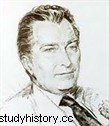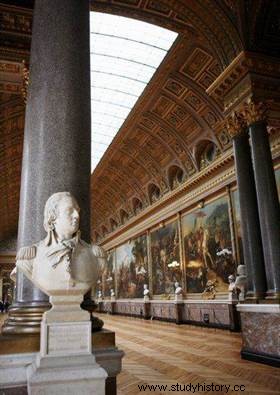 After the Second World War, the Palace of Versailles required considerable restoration work. After the tragic death of curator Charles Mauricheau-Beaupré and among the crowd of applicants for this sought-after post, Gérald Van Der Kemp stands out, becoming for twenty-seven years The Chief Curator of Versailles .
After the Second World War, the Palace of Versailles required considerable restoration work. After the tragic death of curator Charles Mauricheau-Beaupré and among the crowd of applicants for this sought-after post, Gérald Van Der Kemp stands out, becoming for twenty-seven years The Chief Curator of Versailles .
Gérald Van Der Kemp passionate about art
Gérald Van Der Kemp born in May 1912 in Charenton-le-Pont, studied at the Nantes high school where he was passionate about painting and drawing. At the age of seventeen he returned to Paris, and in order to survive he did some caricatures for the newspapers, a few film sets and a vague preparation for the Beaux-arts. After the Foreign Legion in Morocco and then a stint at the Sorbonne, he enrolled at the Ecole du Louvre, obtaining at the age of twenty-four his license in archeology accompanied by his diploma. The director of the National Museums Henri Verne summons him and offers him the title of independent attaché with a salary of 800 francs per month!
Chargé de mission at the Department of Drawings and Engravings of the Louvre in 1936, he stood out during the Occupation by saving works of art, by confronting an SS division for protect in particular the Venus de Milo and the Slaves of Michelangelo, transferred to Valençay. This earned him a magnificent citation and his appointment to the order of the Legion of Honor on a military basis:"By his courageous attitude, Gérald Van Der Kemp preserved the Museum deposit entrusted to him from fatal destruction and limited the progress of the fire started in the town of Valençay by the Germans of the Nazi division Das Reich...”.
Already nicknamed "VDK", at the age of forty he rose to the post of chief curator "acting" at Versailles in 1953 following a real contest of circumstance :his predecessor Charles Mauricheau-Beaupré was the victim of a car accident in Canada in April; while the greatest curators in France jostled for this position, André Cornu, Secretary of State for Fine Arts, chose him and appointed him definitively two years later.
He discovers Versailles in an almost lamentable state:“When I arrived there, it was disgusting, empty, dead. I wanted it to become alive again, beautiful to look at, what it was in the time of kings. It had to be furnished, clothed, dusted off”. Versailles no longer fascinates, but luck is with VDK:Sacha Guitry is shooting between July and September 1953, his film "If Versailles was told to me" and offers part of the rights to safeguard the Palace of Versailles.
Gérald Van Der Kemp's missions
VDK begins by eliminating tours of Versailles made by guards and replacing them with guided tours organized by students; he then set up a restaurant and public toilets under the Gabriel wing (as in the great museums), having the feeling that the brand image of a cultural establishment depends on its quality of services; he organized his first major exhibition in 1955 “Marie Antoinette, Archduchess, Dauphine and Queen” helped by the contribution of Baroness Elie de Rothschild. The result is not long in coming:more than 250,000 visitors pass.
 VDK feels it needs permanent specialists and encourages mastery of craftsmanship; he began by developing workshops for models, carpentry, watchmaking, gilding, tapestry, cabinetmaking, sculpture; he creates a large archive service and a photo lab. It facilitates in this way the restoration of the Grand Trianon, the Museum of the History of France, the apartment of Madame de Maintenon, the apartments of Louis XV, the apartments of Madame du Barry, the dining room of Louis XV at the Petit Trianon, the king's bedroom, Louis XVI's games room, his library, and dozens of other rooms, antechambers or small cabinets. He is also in charge of the renovation of the Napoleonic rooms of the National Museum of the History of France created by Louis-Philippe.
VDK feels it needs permanent specialists and encourages mastery of craftsmanship; he began by developing workshops for models, carpentry, watchmaking, gilding, tapestry, cabinetmaking, sculpture; he creates a large archive service and a photo lab. It facilitates in this way the restoration of the Grand Trianon, the Museum of the History of France, the apartment of Madame de Maintenon, the apartments of Louis XV, the apartments of Madame du Barry, the dining room of Louis XV at the Petit Trianon, the king's bedroom, Louis XVI's games room, his library, and dozens of other rooms, antechambers or small cabinets. He is also in charge of the renovation of the Napoleonic rooms of the National Museum of the History of France created by Louis-Philippe.
Having acquired great notoriety, nicknamed "the Commander", qualified as a Man of restoration and refurnishing, VDK manages to reconstruct the Queen's bedroom, in the state from 1788-1789 with hangings, furniture, woodwork similar to that time. He must end in style ... with the restoration of the Hall of Mirrors. From 1973, he prepared for this new adventure by giving a dazzling evening sponsored by Marie-Hélène de Rothschild. He thus collected 250,000 dollars, the beginning of an extraordinary patronage. The Hall of Mirrors restored to its original splendor was inaugurated in June 1980.
Support from politicians and patronage
After a few misunderstandings with chief architect André Japy, who was retired, VDK knew that it needed political support and "ears" to listen, because without connections, no credits to restore the premises. Thus he can count on André Malraux, Minister of Cultural Affairs, who is organizing the repatriation of a masterpiece from the Louvre to Versailles.
He also intends to refurnish Versailles with the original furniture scattered around the Louvre or Fontainebleau or to recreate copies of furniture as originally. Thanks to his political knowledge, Michel Debré Prime Minister at the time passed a decree in February 1961 “all paintings and works that belonged to Versailles must be returned to the National Museum of Versailles and the Trianons”. VDK himself says “I engaged in a life-and-death struggle with my colleagues from the other national museums. No one wanted to "drop" neither furniture nor paintings. I needed them to give Versailles back the life that had deserted it”.
He develops patronage through his own connections and his second wife, traveling to Europe and America to find generous benefactors. He himself organizes sumptuous dinners welcoming Grace Kelly or Herbert Von Karajan. Elected to the Academy of Fine Arts in 1968, assigned in 1980 to Claude Monet's estate in Giverny, he died at the end of December 2001 in Paris.
Tributes to the very great chief curator
Great personalities paid tribute to him after his death, in particular Marc Ladreit de Lacharrière elected in 2006 to the former seat of Gérald Van Der Kemp who said "We can't take a step at Versailles without seeing the imprint of his passage there". Alain Baraton, head gardener of Versailles, says "Anyone who knows the history of Versailles knows that we owe him in particular the restoration of the Queen's bedroom as well as the restitution of the furniture, including the King's office, masterpieces cabinet-making from the 18th century, scattered here and there in the ministries according to the whims of republics and revolutions; it was Van Der Kemp's life's work:identically reweaving the two silks in the royal apartments took 25 years respectively for the Queen's bedroom and 30 for the King's”.
Gérald Van der Kemp was a true precursor of modern patronage. Public money being scarce, he worked with ardor and success to convince major collectors around the world of the absolute necessity of supporting and financing the restoration of Versailles in order to preserve our heritage. Placed at the exclusive service of the arts, this elegant, respectful, energetic, determined leader of men remained twenty-seven years in his post, having succeeded in making the Palace of Versailles a magnificent showcase of French decorative arts, a major center heritage.
To go further
- "They saved Versailles", by Franck Ferrand. Editions Perrin, 2003.
- “A gentleman at Versailles”, by Franck Ferrand. Editions Perrin, 2005.
- “The Gardener of Versailles” by Aalain Barraton. Grasset, 2006.
